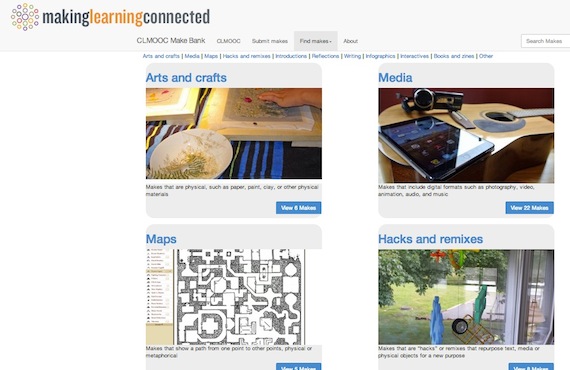How I Spent My Summer Playing with Teachers
A MiddleWeb Blog
It seems a bit unprofessional to put it like that, as if “playing” were some term that we shouldn’t be using when sharing out what it means to be an educator furthering our practice during the summer break. And yet … teachers really do need to find more ways to play — to tinker, to explore, to learn, to make.
For me, summer play has meant being a facilitator/participant in the Making Learning Connected Massive Open Online Collaboration, or #CLMOOC, for the second year in a row. The energy and excitement that comes out of six weeks spent diving into the act of playing and making (in online and offline spaces) is sure to remind the hundreds of #CLMOOC participants, and myself, of the nature of childhood inquisitiveness and the power of play.
A prime example of open learning
The Making Learning Connected MOOC, sponsored by the National Writing Project and part of the Educator Innovator initiative, is a prime example of an open learning experience. Unlike some of the MOOCs offered by universities and for-profit companies, the #CLMOOC was free and open, and participants were welcome to come when inspired and leave when they wanted. We even valued the role of lurkers all summer long, knowing that watching is often the first step toward doing.

The #CLMOOC was designed on the anchors of Connected Learning theory, of fostering engagement along lines of shared interests that emerge from audience and peers in a real world setting. The philosophical underpinning of Connected Learning is that we learn by doing and making, and that if teachers experience that understanding themselves, by doing, they are more likely to bring those concepts into their own classrooms.
So, what was the summer like? Full of fun.
Learning through “Make Cycles”
The #CLMOOC was structured around Make Cycles, which are project ideas sponsored by various teams from around the country, with work by participants flowing in any number of spaces, either online (using Google Plus, Twitter, blogs, etc.) or in person (mostly at Writing Project sites but also at libraries, media centers and other spaces).
Some of the Make Cycles included: creating a How To Do Something tutorial, hacking and remixing your writing, making viral memes, playing with light and story, using visual imagery and more. Weekly Twitter Chats and Google Hangouts kept the themes flowing throughout the Make Cycles, and support came not just from facilitators like myself but also from participants, who made important connections with each other.
On any given day in the #CLMOOC, there might be dozens of projects being created and shared, with conversations flowing about the process of learning and reflective stances, and discussions about the merits of trying the Make Cycle ideas in the classroom. People dropped in and out all summer. It’s the kind of learning environment that we hope to nurture in our own classrooms, and it’s unfolding in virtual spaces as a free model for us all.
A bank of legacy projects
The community even created a legacy project — the Make Bank, where dozens of Make Projects have been shared by participants throughout this summer, and last. Grouped within categories including media and reflections and infographics and more, the submissions in the Make Bank are rich learning experiences, and they demonstrate the collective power of a group of active learners publishing ideas for the real world.
At one point, I created this Padlet site for some of the projects that I created myself, grouping what I had accomplished under the themes of the Connected Learning Principles. Even so, this collection is just the tip of the iceberg of what I did all summer, as collaboration projects took off in every direction and discussions among fellow educators enriched my world beyond measure, and made me think and rethink my own ideas of teaching.
If you missed the #CLMOOC this summer, we missed you, too. There’s always next year, we hope, and there’s another nifty thing about open education spaces: the doors never really close on the learning. So, come on into the #CLMOOC and make something happen. Or head on over to the Make Bank and get creative. You won’t be alone in the endeavor. I guarantee it.

































